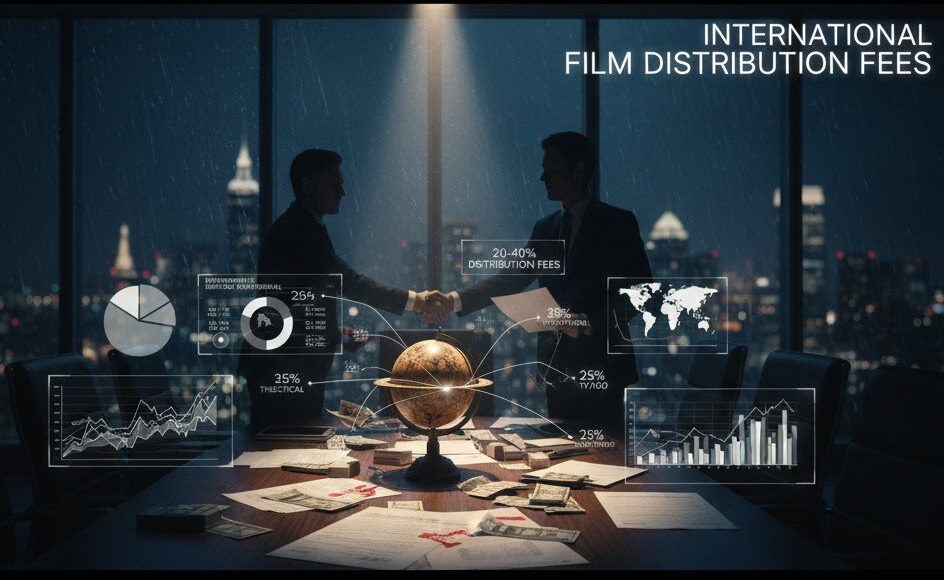Introduction
Your film is made, the deals are potentially brewing, but how does your movie actually reach the eyes and ears of the audience? This is where understanding film distribution channels becomes absolutely essential. In today’s multifaceted media world, the pathways to viewers are more varied than ever, ranging from the classic big screen experience of theatrical film distribution to the ever-expanding universe of streaming distribution for films, traditional TV distribution deals, and the diverse options within VOD film distribution.
And it doesn’t stop there; niche avenues like educational film distribution and even airline film distribution offer further opportunities. For producers, distributors, and sales agents, effectively navigating these channels is key to maximizing a film’s reach and revenue. Let’s explore these pathways!
Table of content
- Introduction
- Key-Takeaways
- What Are Film Distribution Channels and Why Do They Matter?
- The Big Screen Dream: A Deep Dive into Theatrical Film Distribution
- The Streaming Revolution: SVOD, AVOD, and TVOD Explained
- Television’s Enduring Role: Broadcast and Cable Distribution
- Beyond the Mainstream: Ancillary Film Distribution Channels
- Strategic Windowing and Channel Selection
- Conclusion
- FAQs
Key Takeaways
| Distribution Channel | Core Characteristic |
|---|---|
| Theatrical Distribution | Cinema release; offers prestige and potential for high impact, but is competitive and costly. |
| Streaming (SVOD/AVOD/TVOD) | Digital delivery via platforms like Netflix (SVOD), Tubi (AVOD), or iTunes (TVOD); offers global reach and diverse monetization. |
| Television Distribution | Broadcast on linear TV (free-to-air, cable, satellite); good for reaching broad demographics or specific channel audiences. |
| Ancillary Channels | Includes educational, inflight (airline), hospitality, and physical media; provides additional revenue streams and niche audience access. |
| Strategic Windowing | The planned sequence of release across different channels to optimize revenue and audience engagement over time. |
Maximize Your Film's Reach and Revenue Potential!

What Are Film Distribution Channels and Why Do They Matter?

Film distribution channels are the various pathways or platforms through which a completed film is made available to its intended audience. Think of them as the different roads your movie can travel to reach viewers. These channels range from traditional movie theaters to the latest streaming apps on your phone. Understanding these channels matters immensely because your choice of (or access to) specific channels will directly impact your film’s visibility, its potential audience size, its revenue streams, and even its perceived prestige. A film primarily targeting theatrical film distribution will have a very different release plan and marketing approach compared to one focused on direct-to-streaming distribution for films. Each channel has its own economics, audience expectations, and technical requirements.
Defining the landscape of modern film distribution.
The modern landscape of film distribution channels is a dynamic mix of old and new, physical and digital:
- Physical Venues: Primarily movie theaters, but can also include event screenings in community halls, universities, etc.
- Digital Platforms: This is a vast and growing area, encompassing:
- Subscription Video on Demand (SVOD) services.
- Advertising-supported Video on Demand (AVOD) services.
- Transactional Video on Demand (TVOD) for digital rental or purchase.
- Direct-to-consumer (DTC) websites or apps.
- Broadcast Television: Linear TV channels, including free-to-air networks, cable channels, and premium satellite offerings.
- Specialized/Ancillary Markets: Such as educational institutions, airlines, hotels, and even physical media (DVD/Blu-ray).
The lines between these channels can sometimes blur, with hybrid releases and evolving windowing strategies becoming more common.
How channel selection impacts audience reach and revenue.
The film distribution channels you utilize will profoundly affect who sees your film and how money is made:
- Audience Reach: A wide theatrical release might reach millions in a short burst, while a global SVOD platform offers sustained access to a massive subscriber base. Niche channels like educational film distribution target very specific demographics.
- Revenue Models:
- Theatrical: Box office splits between distributors and exhibitors.
- VOD: License fees from SVOD platforms, revenue shares from TVOD rentals/sales, ad revenue from AVOD.
- TV: License fees paid by broadcasters for airing rights.
- Ancillary: Sales or licensing fees specific to those markets (e.g., per-screen fee for airlines).
- Marketing & Costs: Different channels require different levels of marketing spend and have varying distribution costs associated with them.
- Perceived Value: Certain channels (like a prestigious theatrical run or a premiere on a major streamer) can enhance a film’s perceived value and awards potential.
A strategic selection and sequencing of these film distribution channels are crucial for maximizing both cultural impact and financial return.
| Channel Type | Primary Delivery Method | Key Impact Area |
|---|---|---|
| Theatrical | Physical cinemas | Prestige, event-driven viewing, initial buzz. |
| Streaming (SVOD/AVOD/TVOD) | Digital internet platforms | Global reach, diverse monetization, viewer convenience. |
| Television | Linear broadcast/cable/satellite | Broad demographic access, scheduled viewing. |
| Ancillary (Educational, Airline) | Varied (physical, closed-circuit, digital) | Niche audience targeting, incremental revenue. |
Understanding these distinctions is fundamental for any producer, distributor, or sales agent working in film today.
The Big Screen Dream: A Deep Dive into Theatrical Film Distribution
For many filmmakers, theatrical film distribution represents the pinnacle of achievement – seeing their work projected onto the silver screen in front of a captive audience. While the landscape is evolving, a cinema release still holds significant cultural weight and can be a powerful launchpad for a film. However, it’s also one of the most complex and expensive film distribution channels to navigate successfully. It involves intricate relationships between distributors and exhibitors (cinema owners), substantial marketing investment, and careful strategic planning around release dates and screen counts.
The process of getting a film into movie theaters.
The journey to a theatrical release typically involves:
- Acquisition by a Distributor: A distribution company acquires the theatrical rights for a film in a specific territory.
- Marketing & P&A Strategy: The distributor develops a plan and budget for Prints & Advertising (P&A), which includes creating trailers, posters, running ad campaigns, and press outreach. This is often the largest expense.
- Booking Theaters: The distributor’s bookers negotiate with cinema chains and independent theaters to secure screens and showtimes for the film. This involves deciding on the release date, the number of screens, and the length of the run.
- Physical/Digital Print Delivery: Creating and delivering Digital Cinema Packages (DCPs) – the digital equivalent of film prints – to theaters.
- Box Office Collection & Reporting: Theaters report ticket sales, and revenues are split between the exhibitor and the distributor according to agreed terms (which can be complex and vary by film and week of release).
Pros and cons of theatrical releases for different types of films.
Pros:
- Prestige and Visibility: A theatrical release can generate significant media attention, critical reviews, and awards buzz.
- Enhanced Ancillary Value: A successful theatrical run can increase the value of a film in subsequent windows (VOD, TV).
- Communal Viewing Experience: Offers an unparalleled shared experience for audiences.
- Potential for High Box Office Revenue: For blockbuster films or breakout hits.
Cons:
- High Costs: P&A expenses can be enormous, often exceeding the film’s production budget.
- Very Competitive: Securing screens, especially on good dates, is incredibly challenging due to the volume of films.
- Financial Risk: If a film underperforms at the box office, losses can be substantial.
- Not Suitable for All Films: Smaller, niche films may struggle to find an audience or justify the costs of a wide theatrical release. They might be better suited for limited releases or other film distribution channels.
| Theatrical Aspect | Description | Key Consideration |
|---|---|---|
| Prints & Advertising (P&A) | Costs associated with marketing and creating exhibition prints/DCPs. | Often the largest single expense in a theatrical release. |
| Exhibitor Relations | Negotiations and relationships with cinema owners/chains. | Crucial for securing screens and favorable terms. |
| Release Windowing | Timing of theatrical release relative to other channels. | Impacts overall revenue strategy and subsequent deals. |
| Box Office Performance | Ticket sales revenue. | Highly unpredictable, dictates financial success of theatrical run. |
Despite challenges, theatrical film distribution remains a vital and aspirational part of the industry for many films.
The Streaming Revolution: SVOD, AVOD, and TVOD Explained
The rise of streaming platforms has fundamentally reshaped film distribution channels, offering unprecedented access for viewers and new avenues for filmmakers. Streaming distribution for films encompasses several models, primarily Subscription Video on Demand (SVOD), Advertising-supported Video on Demand (AVOD), and Transactional Video on Demand (TVOD). Each model has its own economics, audience reach, and strategic implications for producers and distributors. Understanding these distinctions is crucial for crafting effective modern distribution strategies.
SVOD (Subscription Video on Demand): The Netflix Effect.
SVOD platforms like Netflix, Amazon Prime Video, Disney+, HBO Max, and Apple TV+ operate on a subscription model. Users pay a recurring fee for access to a vast library of content.
- For Filmmakers/Distributors: Deals often involve a flat license fee for a set term (e.g., 1-3 years) for exclusive or non-exclusive rights. Global deals are common.
- Audience: Massive subscriber bases, often with sophisticated recommendation algorithms driving discovery.
- Content Focus: Ranges from big-budget “Originals” to library content and acquired independent films. Competition for placement is fierce.
AVOD (Advertising-supported Video on Demand): Free for All, Fueled by Ads.
AVOD platforms like Tubi, Pluto TV, Peacock (free tier), and The Roku Channel offer content for free to viewers, with revenue generated from advertising shown during programming.
- For Filmmakers/Distributors: Deals typically involve a revenue share based on ad impressions or hours viewed. Non-exclusive deals are common.
- Audience: Growing rapidly as a free alternative to subscriptions; attracts a broad demographic.
- Content Focus: Often extensive libraries of older films and TV shows, but increasingly also exclusive content and FAST (Free Ad-supported Streaming TV) channels.
TVOD (Transactional Video on Demand): Pay-Per-View Power.
TVOD platforms like iTunes/Apple TV, Amazon Prime Video Store, Google Play, and Vudu allow users to rent or purchase films digitally on a pay-per-title basis. This is often an early “home entertainment” window.
- For Filmmakers/Distributors: Revenue is typically a share of the rental or purchase price. Aggregators often facilitate placement on these platforms for independent films.
- Audience: Viewers willing to pay for early access to new releases or to own specific titles.
- Content Focus: New theatrical releases, premium direct-to-VOD titles, and library films for purchase.
Many films will utilize a combination of these VOD film distribution models as part of their overall release strategy across different film distribution channels.
| Streaming Model | Revenue Source for Platform | Typical Deal for Filmmaker | Audience Proposition |
|---|---|---|---|
| SVOD | Monthly/Annual Subscriptions | Upfront License Fee (often exclusive) | Large library for one recurring price. |
| AVOD | Advertising | Revenue Share (often non-exclusive) | Free access to content with ads. |
| TVOD | Per-Title Rental/Purchase Fees | Revenue Share per transaction | Pay only for what you watch (early access/ownership). |
The dynamic world of streaming distribution for films continues to evolve, offering diverse opportunities.
Don't Miss Out on Niche Distribution Opportunities!

Television’s Enduring Role: Broadcast and Cable Distribution
Despite the seismic shifts caused by streaming, traditional television remains a significant player among film distribution channels. Securing TV distribution deals can provide substantial revenue and reach large, established audiences. This includes free-to-air broadcast networks, cable channels (basic and premium), and satellite television providers. While viewing habits are changing, TV still commands a huge number of eyeballs globally, particularly for certain demographics and types of content.
Free-to-Air, Cable, and Pay-TV: Opportunities and Deal Structures.
The TV landscape includes:
- Free-to-Air Broadcast TV: Networks funded by advertising (e.g., ABC, NBC, CBS in the US; BBC in the UK partly by license fee) that reach very broad audiences. They acquire films for specific broadcast windows, often after theatrical and premium VOD/Pay TV runs.
- Basic Cable Channels: Channels included in standard cable packages, often ad-supported (e.g., TBS, AMC, FX). They license films to fit their brand and programming needs (e.g., genre-specific channels).
- Premium Cable/Pay TV Channels: Subscription-based channels like HBO, Showtime, Starz, offering high-quality, often ad-free movies and series. They pay significant license fees for exclusive first-run TV windows for theatrical films and commission original productions.
Deal structures for TV distribution deals typically involve a license fee paid by the broadcaster for the right to air a film a certain number of times over a specific period within their designated territory.
How television rights fit into a film’s overall distribution strategy.
Television rights are an important part of a film’s “waterfall” of revenue. The value of TV rights can be influenced by:
- Theatrical Performance: A successful theatrical run often increases the value of TV rights.
- Star Power and Genre: Well-known actors and popular genres can command higher license fees.
- Exclusivity and Windowing: The timing of the TV window relative to other releases (theatrical, VOD) impacts its value. First Pay TV windows are highly valued.
- Territorial Value: License fees vary greatly by country and the size/wealth of its TV market.
For many independent films, a sale to a significant TV broadcaster can be a major financial success and provide wide exposure. It remains a cornerstone for many film distribution channels strategies.
| TV Channel Type | Funding Model | Typical Film Acquisition | Audience Profile |
|---|---|---|---|
| Free-to-Air Broadcast | Advertising / Public Funding | Library titles, some premieres (later window). | Very broad, general demographics. |
| Basic Cable | Advertising / Subscription Fees | Genre films, library titles, some original movies. | Varies by channel brand (e.g., sci-fi, comedy). |
| Premium Cable/Pay TV | Subscription Fees | Theatrical blockbusters (first TV window), acclaimed indies, original series/films. | Affluent, seeking high-quality ad-free content. |
Even in the age of streaming, robust TV distribution deals are highly sought after.
Beyond the Mainstream: Ancillary Film Distribution Channels
While theatrical, streaming, and TV dominate much of the conversation about film distribution channels, a range of ancillary or “non-traditional” markets offer valuable opportunities for additional revenue and audience engagement. These channels, such as educational film distribution, airline film distribution (inflight entertainment), hospitality, and even physical media, can be particularly important for certain types of films and can complement a broader distribution strategy. Exploring these avenues can uncover hidden gems of revenue and reach.
Educational Distribution: Reaching Students and Institutions.
Educational film distribution involves making films available to schools (K-12), universities, libraries, museums, and other educational organizations. This channel is particularly relevant for:
- Documentaries
- Films with historical or social issue themes
- Adaptations of literature
- Foreign language films for language learning
Deals can involve sales of DVDs/digital files with public performance rights, or licenses for inclusion in educational streaming platforms. Specialized distributors often focus on this market.
Airline and Other Niche Markets (Hospitality, Physical Media).
Other notable ancillary film distribution channels include:
- Airline Film Distribution (Inflight Entertainment): Airlines license films to entertain passengers. Content is typically curated for broad appeal and often includes recent theatrical releases as well as library titles.
- Hospitality: Hotels, cruise ships, and sometimes even prisons or military bases license films for their closed-circuit entertainment systems.
- Physical Media (DVD/Blu-ray): While declining, this market still exists, particularly for collector’s editions, special interest titles, and in regions where broadband access is less prevalent. Some distributors still specialize in physical media releases.
- Community Screenings/Non-Theatrical: Licensing films for public screenings by film societies, community groups, or organizations, often tied to specific events or themes.
While individually these might seem small, collectively, ancillary revenues can be significant for some films.
How Vitrina can help identify opportunities in niche channels.
Navigating these diverse and sometimes fragmented ancillary film distribution channels can be challenging. Platforms like Vitrina can provide valuable market intelligence by:
- Identifying Specialized Distributors: Helping filmmakers find distributors who focus on niche markets like educational or inflight entertainment.
- Tracking Content Trends: Revealing what types of films are being acquired for these specialized channels.
- Global Reach: Providing insights into which ancillary markets might be viable in different international territories.
By using data from Vitrina’s solution, producers and sales agents can make more informed decisions about pursuing these often-overlooked but potentially lucrative film distribution channels.
| Ancillary Channel | Target Audience/Setting | Type of Content Often Suited |
|---|---|---|
| Educational | Schools, universities, libraries | Documentaries, historical films, social issue films. |
| Airline (Inflight) | Airline passengers | Recent theatrical releases, popular library titles, family films. |
| Hospitality (Hotels, etc.) | Guests in hotels, on cruise ships | Broad appeal movies, TV series. |
| Physical Media | Collectors, regions with limited streaming | Special editions, genre films, kids’ content. |
Exploring these “beyond the mainstream” channels is a smart move for a comprehensive distribution plan.
Strategic Windowing and Channel Selection
Successfully navigating the multitude of film distribution channels isn’t just about getting your film onto as many platforms as possible; it’s about strategic timing and selection. “Windowing” is the industry term for the planned sequence and timing of a film’s release across different distribution channels (e.g., theatrical, then TVOD, then SVOD, then TV). The goal of strategic windowing is to maximize revenue from each channel before moving to the next, while also managing exclusivity and audience anticipation. Choosing the right combination of film distribution channels and the right windowing strategy is critical for a film’s overall financial success and market impact.
The concept of “release windows” and their evolution.
Traditionally, release windows were fairly rigid and long:
- Theatrical Window: Exclusive cinema release (e.g., 90+ days).
- Home Entertainment Window: TVOD (rental/purchase), DVD/Blu-ray.
- Pay TV Window: Premiere on premium cable channels.
- Subscription Streaming Window: Availability on SVOD platforms.
- Free TV Window: Broadcast on free-to-air networks.
However, the rise of powerful streaming services and changing consumer habits have led to significant evolution and compression of these windows. We now see:
- Shorter Theatrical Windows: Some films move to VOD much faster (e.g., 17-45 days).
- Day-and-Date Releases: Films releasing simultaneously in theaters and on a streaming platform or PVOD (Premium VOD).
- Straight-to-Streaming Releases: Bypassing theatrical altogether for a global streaming premiere.
The “right” windowing strategy is now more film-specific and market-dependent than ever.
Factors influencing the choice and sequencing of distribution channels.
When deciding which film distribution channels to use and in what order, consider:
- The Film Itself: Is it a big-budget spectacle suited for theaters, or a niche documentary perfect for educational platforms and targeted SVOD?
- Target Audience: Where does your target audience consume content?
- Financial Goals: Are you aiming for a quick return via PVOD, or building long-term library value on SVOD?
- Marketing Budget: A wide theatrical release requires substantial P&A; a digital-first release might rely more on online marketing.
- Distributor Relationships and Deals: The terms negotiated with distributors will dictate windowing for their specific rights.
- Competitive Landscape: What other films are releasing around the same time?
- Territorial Differences: Windowing practices can vary significantly from one country to another.
There’s no single magic formula; it’s about a bespoke strategy for each film. This strategic thinking applies whether it’s theatrical film distribution, streaming distribution for films, or planning for TV distribution deals.
| Windowing Strategy | Description | Potential Benefit | Potential Downside |
|---|---|---|---|
| Traditional Long Windows | Sequential release with significant time between channels. | Maximizes revenue from each exclusive window. | Can lead to piracy if demand outstrips legal availability. |
| Compressed Windows | Shorter time between theatrical and home release. | Capitalizes on initial marketing buzz quickly. | May reduce theatrical attendance for some. |
| Day-and-Date Release | Simultaneous theatrical and VOD/streaming launch. | Offers consumer choice, can boost streaming subscriptions. | Often opposed by theatrical exhibitors, can cannibalize box office. |
| Straight-to-Streaming | Bypasses theatrical for an exclusive platform launch. | Global reach, potentially large license fee. | Loses theatrical prestige and revenue stream. |
Choosing the right path through the various film distribution channels is a complex but crucial task.
Conclusion
Successfully navigating the complex web of film distribution channels is fundamental to achieving your film’s artistic and commercial goals. From the prestige of theatrical film distribution and the global reach of streaming distribution for films, to the enduring power of television and the targeted opportunities in ancillary markets like educational film distribution or airline film distribution, each pathway offers unique advantages. By understanding the nuances of these channels, employing strategic windowing, and tailoring your approach to your specific film and audience, you can effectively connect your cinematic creations with viewers across the globe. The journey requires diligence, adaptability, and a clear vision for where you want your film to go.
Ready to make informed decisions about your film’s distribution journey? Explore Vitrina for unparalleled insights into global content availability, platform needs, and active distributors across all film distribution channels.
Frequently Asked Questions
There’s no single “most profitable” channel, as it depends entirely on the film, its budget, its audience, and the deals secured. A blockbuster might find theatrical most profitable, while a niche documentary could earn more over time through educational sales and targeted SVOD placement. A diversified strategy across multiple relevant film distribution channels often yields the best overall return.
Getting onto major SVOD platforms is highly competitive. Ways to do this include: working with a sales agent or distributor who has a relationship with the platform, having a film that performs exceptionally well at a top-tier festival, or sometimes through aggregator services (though this is more common for TVOD or smaller SVODs). Major platforms often prioritize their own “Originals” or films with significant buzz/star power.
P&A stands for “Prints & Advertising.” “Prints” refers to the cost of creating the Digital Cinema Packages (DCPs) that are sent to movie theaters. “Advertising” covers all marketing expenses for the theatrical release, such as trailers, posters, TV spots, online ads, and PR. P&A is often the largest expense for a theatrical distributor.
Yes, for many films, it remains highly relevant. A theatrical release can create significant cultural impact, generate substantial revenue, enhance a film’s prestige, and drive higher value in subsequent ancillary markets. However, its importance varies by film type, and the model is continuously evolving alongside streaming.
Want the complete picture? Read our essential guide on modern film sales and distribution here: The Essential Guide to Film Sales and Distribution in the Modern Era: From Strategy to Global Reach.






































